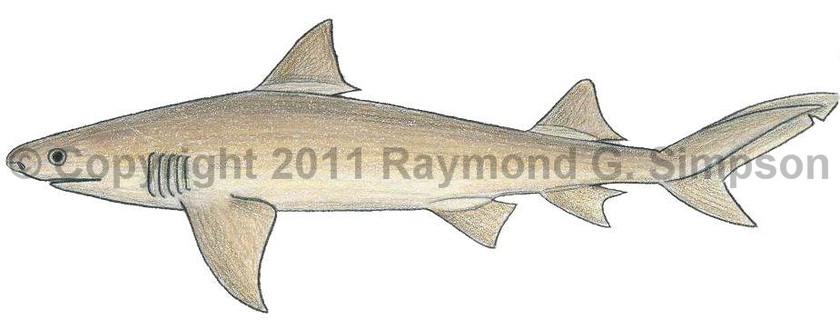
Common Name
Lemon Shark
Year Described
Poey, 1868
Identification
Anteroposterior tooth rows: 15/14-15 on each side; 30-33/29-33 total
Vertebrae: 117-121 precaudal, 197-206 total
A large shark with a robust body. Snout short with a broad tip. Eye small. Distance between nostrils 0.7-1.1 times in pre-oral distance. Nasal flaps triangular and low. Upper labial furrows short. Interdorsal ridge is absent. Long preanal ridge absent. No keels on caudal peduncle. Gill slits long (3.4-4.1% TL). Teeth in upper jaw narrow, with erect and smooth cusps. Lower jaw teeth similar to upper. First dorsal fin fairly high (6.6-8.9% TL) with a straight anterior margin, a narrow rounded tip, and inserted behind free tip of pectoral fin. First dorsal closer to pelvic fin than pectoral fin. Second dorsal fin almost as large as the first (5.5-8.0% TL) and inserted slightly anterior to anal fin. Both dorsal fins with extended free posterior tips (second dorsal free tip less than height of second dorsal). Anal fin similar in size to second dorsal fin. Pelvic fin closer to anal fin than to dorsal fin. Pectoral fin large, broad, and falcate.
Color
Yellowish-brown, yellowish-gray, to olive above, grading to whitish below.
Size
Mature adults from 220-300cm TL. Newborns from 60-65cm. Maximum size to 340cm TL.
Habitat
Most frequently found in shallow coastal waters close to the bottom. Infrequently pelagic in deeper waters (to 92m). Sometimes ventures into estuaries. Often found laying on the bottom in shallow tropical waters.
Range
New Jersey to southern Brazil, including the Gulf of Mexico and the Caribbean Sea.
References
Castro, J.I. 2011. The Sharks of North America. Oxford University Press, 640 pp.
Compagno, L.J.V. 2002. Sharks. In: Carpenter, K.E. (Editor) FAO Identification Guide for Fishery Purposes. The Living Marine Resources of The Western Central Atlantic. Volume 1: Introduction, mollusks, crustaceans, hagfishes, sharks, batoid fishes, and chimaeras. ASIH Special Publication No. 5. FAO, Rome.
Compagno, L., M. Dando, and S. Fowler. 2005. Sharks of the World. Princeton University Press, 480 pp.